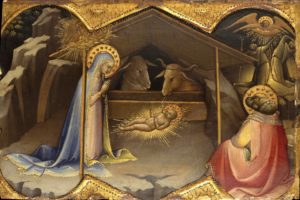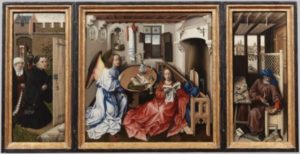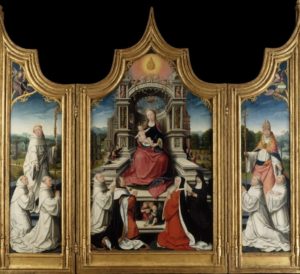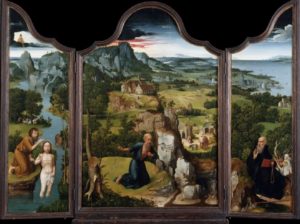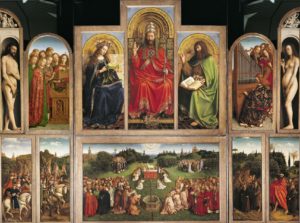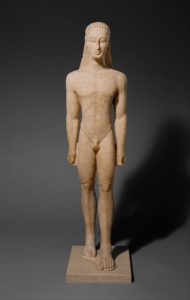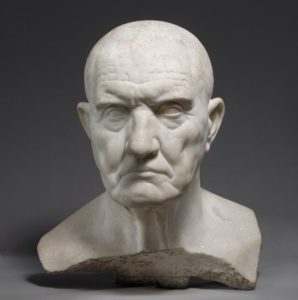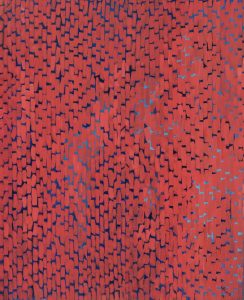Religious Altarpieces and their significance to followers
Introduction:
I am looking specifically these art pieces because they relate to my topic of art with religious symbolism. This is also why they are all religious altarpieces. Christian followers have prayed to these pieces so they are guaranteed to have significant religious importance. They were objects of worship in churches and possibly in homes that represented the people’s faith in God. This strong devotion can be seen in the religious symbolism of the artwork. And some of these altarpieces are also built in a way that it surrounds you because they are large in size to create a sense of awe. I mainly want to look at the religious references like how a devoted christian would see it in an scholarly point of view. Why did they see these as important parts of their lives?
-Lorenzo Monaco, The Nativity, 1406-1410
Location: The Met

This is a painting made by Lorenzo Monaco between 1406-1410, titled “The Nativity”. It’s dimensions are 9 in by 12 in. There are 3 main figures in the painting. The Christ child is the center of attention, the virgin that is kneeling to the left adoring the Christ child she came birth to while the sun is above her head, and saint Joseph in the right looking up to the vision of the angel announcing to the Shepherd in the up right corner. Behind the Christ child is an Ox and a Donkey looking down on it. The virgin, saint Joseph, the angles and Christ child are represented as divine because they have visible golden halos. But Christ child and the angels are showing more divinity because they are emitting golden rays of light from their bodies. This includes the sun that will obviously emit rays of light. Their importance is even more accentuated by the contrast of the bright divine figures lighting up the dark backdrop. This can be seen as telling people that God’s light will make things clear and show you the path towards clarity. I chose this painting because it is an religious Altarpiece like all the other works below. I also chose this because it is symbolic of the devotion followers have for Christian divinity.
Source: The Met’s Heilbrunn Timeline of Art History, www.metmuseum.org/art/collection/search/459007.
-Robert Campin, Merode Altarpiece, 1425
Location: The Met
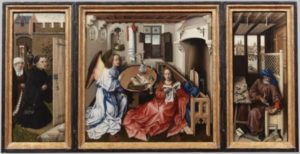
Merode Altarpiece was made in 1432 in the workshop of Robert Campin. It is also known as “Annunciation Triptych”. It’s dimensions are 2 ft by 4 ft. The painting depicts the archangel Gabriel Virgin announcing to Virgin Mary that she will give birth to Jesus Christ in a house that looks to be from Northern Europe in the 1400’s even though this scene would have fallen place 1500 years before the painting was made. This biblical event takes place in a typical high class household to make these figures feel closer to followers, making prayers feel more profound and closer to God. This painting is also dense with objects that have symbolic meaning. Much of it has been lost but there are a few items that are clear. The shiny pot in the back represents the Virgin Mary’s purity and sinlessness. There is a small figure holding a cross gliding towards the the Virgin, representing the Holy Spirit that will make the Virgin pregnant with Christ. When Christ is born, it’s when one world ends and another begins. In this world it’s possible for human beings to be saved because Jesus died on the cross for everyone’s sins. I chose this painting because it potentially holds large amounts of religious symbolism with its many objects in view and its purpose was to make you feel close to God when you pray to the altarpiece.
Source: Harris, Beth and Zucker, Steven. Workshop of Campin, Annunciation Triptych (Merode Altarpiece). YouTube, commentary by Dr. Beth Harris and Dr. Steven Zucker. 4 Feb. 2016, https://www.youtube.com/watch?v=q1X0Lj7YEMs&t=607s
-Jan van Eyck, Ghent Altarpiece, 1432
Location: Saint Bavo Cathedral
This altarpiece is very large and definitely creates a sense of awe when opened up fully. Even when closed, it is a large painting that is to be admired. It is truly a religious altarpiece of the highest caliber. When fully opened, it is 11ft by 15 ft, and when closed, it is 11 ft by 7.5 ft. This is essentially 2 painting in one piece of artwork. It most likely stayed closed most of the year and opened up on feast days as a revelation.
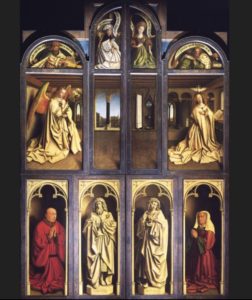
When closed, it shows 8 paintings in total. The 4 at the top shows the prophets and sybils predicting the coming of Christ. Below them is the actual event of the coming of Christ where archangel Gabriel is on the far left panel is announcing to Virgin Mary on the far right panel that she will give birth to Christ, the same scene depicted in the Merode Altarpiece. Gabriel is holding white lilies that represent Mary’s purity and virginity. There are actual words coming out of her mouth from writing on the painting in Latin where she says “Hail Mary, full of grace, blessed art thou among women”. Mary also has words coming out of her mouth with a dove above her head which represents the Holy Spirit. She replies “Behold the handmaiden of the lord”. The difference is that it’s backwards and upside down because she is replying “back”. Although these 4 panels show a high degree of realism, these words stick up in golden lettering, making them ethereal and speaks to God. The 4 panels below show 4 figures, 2 being the patrons that commission the piece and two sculptures that are the 2 Saint John.
Source: Harris, Beth and Zucker, Steven. Van Eyck, Altarpiece (1 of 2). YouTube, commentary by Dr. Beth Harris and Dr. Steven Zucker. 4 Nov. 2013, https://www.youtube.com/watch?v=udgNvPpDb2I
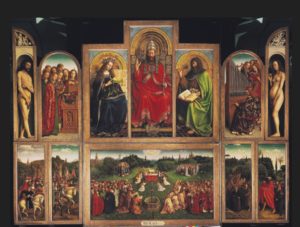
When opened up, you’re overwhelmed with a wall of colors. First thing you see is a large figure in the center depicting of God the father dressed like a king with a gold jeweled papal crown on his head and a gold jeweled crown at his feet to show that he is the king of kings. He also has a scepter that has a clear crystal handle and embellished in gold to represent power. The running theme is God’s saving grace and power, depicting his plan to forgive and redeem mankind. On the left of him is Mary, looking like a queen wearing a crown and on the right of him is Saint John the Baptist. Another symbol of his forgiveness is a pelican, which in the medieval tradition, it was believed that when it’s young was starving, it would pick at it’s flesh to feed them. Representing the sacrifice of God to save humanity. One panel further out is angels singing and playing instruments in heaven. And on the farthest left and right are Adam and Eve naked. They look deeply human and imperfect compared to the other figures mentioned, which can be reflecting God’s willingness to reach out to humanity despite imperfections. Directly below God is an image of 4 groups of people looking towards the scene in the center where a lamb is on an altar. The lamb has a wound on its side where it is pouring out blood into a chalice, representing Christ’s sacrifice. This is because the lamb is shown to be calm and serene with rays of light extending out of it’s head, overcoming earthy pain/suffering. Surrounding the lamb are angels carrying the torture instruments inflicted on Christ to create a sense of sacrifice for the redemption of mankind. These two set of paintings tell a story of Christ and how God has forgiven mankind for its sins through religious symbolism, showing intense devotion to Christianity, creating a sense of awe and pride to be a follower of God.
Source: Harris, Beth and Zucker, Steven. Van Eyck, Altarpiece (2 of 2). YouTube, commentary by Dr. Beth Harris and Dr. Steven Zucker. 10 Nov. 2013, https://www.youtube.com/watch?v=JVhwinCiELI
Conclusion:
These altarpieces are have clear religious significance when looking at religious symbolism represented in the art. All depicting the birth of Christ and Virgin Mary’s importance. The Nativity by Lorenzo Monaco depicts the moment Christ was born, the Merode Altarpiece depicts the announcement to Virgin Mary that she will have the Christ child, and the Ghent Altarpiece depicts the announcement to Virgin Mary and a dense amount of religious symbolism that tells the story of Jesus Christ’s and God’s sacrifice to mankind. The dense symbolism and constant appearance of Mary and Christ tells me that the birth of Christ is seen as the beginning of a world where humans can be forgiven for their sins because of God’s and Christ’s sacrifice. Followers truly believed that they basked in the light of through prayers. I believe that if we didn’t know the deep analysis of these paintings, we wouldn’t understand the deeply established and rooted beliefs of Christianity and would undermine the intense devotion followers had for the the divine. These altarpieces aren’t just pretty paintings, because it’s much more than that.


